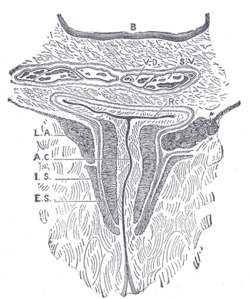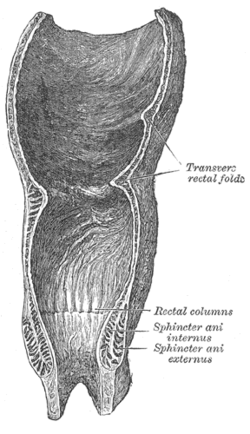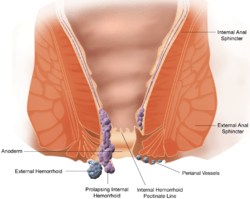Internal anal sphincter
| Internal anal sphincter | |
|---|---|
 Coronal section through the anal canal. B. Cavity of urinary bladder V.D. Vas deferens. S.V. Seminal vesicle. R. Second part of rectum. A.C. Anal canal. L.A. Levator ani. I.S. Internal anal sphincter. E.S. External anal sphincter. | |
 Coronal section of rectum and anal canal. | |
| Details | |
| Nerve | Pelvic splanchnic nerves (S4), thoracicolumbar outflow of the spinal cord |
| Actions | Keeps the anal canal and orifice closed, aids in the expulsion of the feces |
| Identifiers | |
| Latin | Musculus sphincter ani internus |
| TA | A05.7.05.011 |
| FMA | 15710 |
The internal anal sphincter, IAS, (or sphincter ani internus) is a muscular ring that surrounds about 2.5–4.0 cm of the anal canal; its inferior border is in contact with, but quite separate from, the external anal sphincter.
It is about 5 mm thick, and is formed by an aggregation of the involuntary circular fibers of the rectum. Its lower border is about 6 mm from the orifice of the anus.
Actions
Its action is entirely involuntary, and it is in a state of continuous maximal contraction. It helps the Sphincter ani externus to occlude the anal aperture and aids in the expulsion of the feces. Sympathetic fibers from the superior rectal and hypogastric plexuses stimulate and maintain internal anal sphincter contraction. Its contraction is inhibited by parasympathetic fiber stimulation. This sphincter is tonically contracted most of the time to prevent leakage of fluid or gas, but is relaxed upon distention of the rectal ampulla, requiring voluntary contraction of the puborectalis and external anal sphincter.[1] The internal anal sphincter is not innervated by the pudendal nerve, which carries somatic (motor and sensory) fibers that provide the innervation to the external anal sphincter.[2]
Role in continence
The IAS contributes 55% of the resting pressure of the anal canal. It is very important for bowel continence, especially for liquid and gas. When the rectum fills beyond a certain capacity, the rectal walls are distended, triggering the defecation cycle. This begins with the rectoanal inhibitory reflex, RAIR, where the IAS relaxes. This is thought to allow a small amount of rectal contents to descend into the anal canal where specialized mucosa samples whether it is gas, liquid or solid. Problems with the IAS often present as degrees of fecal incontinence (especially partial incontinence to liquid) or mucous rectal discharge.[3]
Additional images
 Intestines
Intestines Schematic demonstrating the anatomy of hemorrhoids.
Schematic demonstrating the anatomy of hemorrhoids.
References
This article incorporates text in the public domain from the 20th edition of Gray's Anatomy (1918)
- ↑ Moore, K., Dalley, A., Ague, A. "Clinically Oriented Anatomy. 6th Edition.
- ↑ http://www.dartmouth.edu/~humananatomy/part_6/chapter_36.html
- ↑ David E. Beck, Patricia L. Roberts, Theodore J. Saclarides, Anthony J. Senagore, Michael J. Stamos, Steven D. Wexner (Editors) (2007). The ASCRS textbook of colon and rectal surgery. New York: Springer. ISBN 0-387-24846-3.